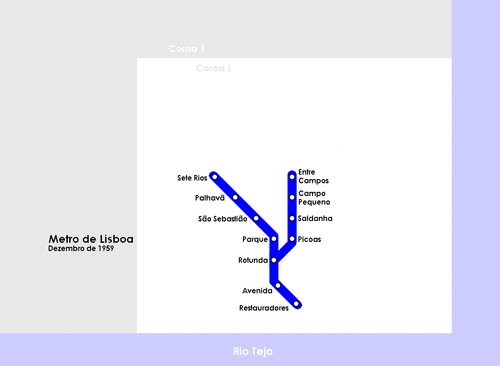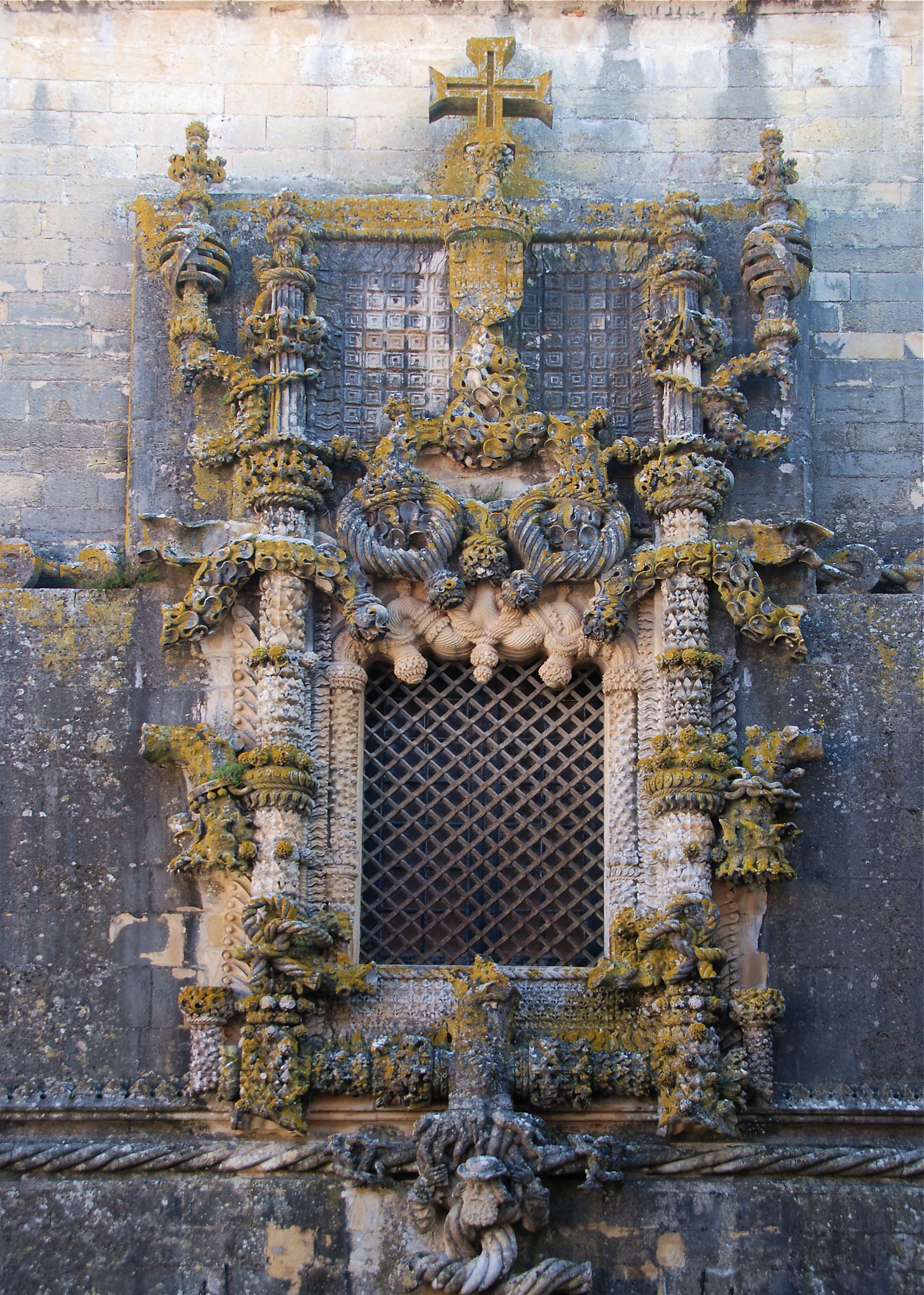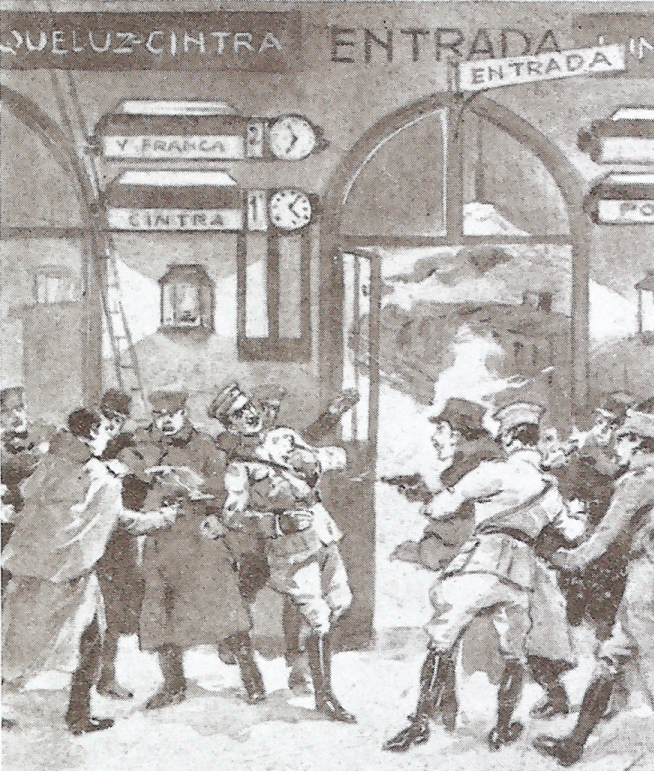|
Rossio Train Station
The Rossio Railway Station (; ) is a railway station in Lisbon, Portugal, located in the Rossio square. The station was formerly known as ''Estação Central'' (Central Station) and that designation still appears in its façade. Trains gain access to the station, which is in the central urban area of Lisbon, through a tunnel which is over long. History The station was commissioned by the Portuguese Royal Railway Company and was designed between 1886 and 1887 by Portuguese architect José Luís Monteiro. It was built in one of the most important squares of Lisbon, the Rossio, and connected the city to the region of Sintra. The tunnel was excavated under the city and is considered one of the most important works of engineering in Portugal dating from the 19th century. It was completed in 1890, and soon after Lisbon's Circle Line with a connection to the North Line also opened. The station became Lisbon's main passenger terminus until 1957, from that date only a few long-d ... [...More Info...] [...Related Items...] OR: [Wikipedia] [Google] [Baidu] |
Rossio Square
The King Pedro IV Square (), popularly known as Rossio (), is a square in the Pombaline Downtown of Lisbon, Portugal. It has been one of its main squares since the Middle Ages. It has been the setting of popular revolts and celebrations, bullfights and executions, and is now a preferred meeting place of Lisbon natives and tourists alike. The square is named after Pedro IV, King of Portugal. The Column of Pedro IV is in the middle of the square. History and highlights Origins The Rossio became an important place in the city during the 13th and 14th centuries, when the population of the city expanded to the lower area surrounding the Lisbon Castle hill. The name "rossio" is roughly equivalent to the word "commons" in English, and refers to a commonly owned terrain. Around 1450, the Palace of Estaus, destined to house foreign dignitaries and noblemen visiting Lisbon, was built on the north side of the square. After the Inquisition was installed in Lisbon, the Palace of Est ... [...More Info...] [...Related Items...] OR: [Wikipedia] [Google] [Baidu] |
President Of Portugal
The president of Portugal, officially the president of the Portuguese Republic (, ), is the head of state and highest office of Portugal. The powers, functions and duties of prior presidential offices, and their relation with the prime minister and cabinets have over time differed with the various Portuguese constitutions. Currently, in the Third Republic, a semi-presidential system, the president holds no direct executive power, unlike his counterparts in the United States and France. However, even though he is in general a ceremonial figure, he holds some powers less-commonly found in parliamentary systems: one of his most significant responsibilities is the promulgation of all laws enacted by the Assembly of the Republic (parliament) or the Government (an act without which such laws have no legal validity), with an alternative option to veto them (although this veto can be overcome in the case of laws approved by Parliament) or send them to the Constitutional Court for a ... [...More Info...] [...Related Items...] OR: [Wikipedia] [Google] [Baidu] |
Lisbon Metro
The Lisbon Metro () is a rapid transit system in Lisbon, Portugal. Opened in December 1959, it was the first rapid transit system in Portugal. , the system's four lines total of route and serve 56 stations. History Initial plans The idea of building a system of underground railways for the city of Lisbon first arose in 1888. It was first proposed by Henrique de Lima e Cunha, a military engineer who had published a proposal in the journal ''Obras Públicas e Minas'' ''(Public Works and Mines)'' for a network with several lines that could serve the Portuguese capital. Concrete plans took longer to evolve, though. Lanoel Aussenac d'Abel and Abel Coelho presented theirs in 1923, and José Manteca Roger and Juan Luque Argenti theirs one year later, in 1924. None of these plans were carried out. After World War II, in which Portugal remained neutral, the national economy took off and the financial possibilities arising from the Marshall Plan provided a strong boost to the pote ... [...More Info...] [...Related Items...] OR: [Wikipedia] [Google] [Baidu] |
Gare Do Oriente
Gare do Oriente (), or alternately, the ''Lisbon Oriente Station'' is one of the main Portugal, Portuguese intermodal transport hubs, and is situated in the Freguesia (Portugal), civil parish of Parque das Nações, Concelho, municipality of Lisbon. History In 1994, the station was proposed as part of the modernization of the Linha do Norte, a modification to the rail line to facilitate the future development of a new station in eastern Lisbon. Located along Avenida D. João II, over Avenida de Berlim and Rua Conselheiro Mariano de Carvalho, the station was planned to occupy the lands once occupied by Apeadeiro dos Olivais, which was demolished in the 1990s in order to make way for the new station. Bids for building the project on lands to be used for the 1998 exposition were solicited internationally. The concept was originally designed by Spain, Spanish architect Santiago Calatrava in 1995, and built by Acciona, Necso. The station was inaugurated on 19 May 1998, as part of th ... [...More Info...] [...Related Items...] OR: [Wikipedia] [Google] [Baidu] |
Sebastian Of Portugal
Sebastian ( ; 20 January 1554 – 4 August 1578) was King of Portugal from 11 June 1557 to 4 August 1578 and the penultimate Portuguese monarch of the House of Aviz. He was the son of João Manuel, Prince of Portugal, and his wife, Joanna of Austria, Princess of Portugal, Joanna of Austria. He was the grandson of King John III of Portugal and Catherine of Austria, Queen of Portugal. He disappeared (presumably killed in action) in the battle of Alcácer Quibir, against the Saadi Sultanate of Morocco. Sebastian I is often referred to as ''the Desired'' () or ''the Hidden'' (), as the Portuguese people longed for his return to end the decline of Portugal that began after his death. He is considered to be the Portuguese example of the King asleep in mountain legend as Portuguese tradition states his return, in a foggy dawn, in Portugal's greatest hour of need. Early life Sebastian was born shortly after eight in the morning of 20 January 1554 (the feast of Saint Sebastian), and he w ... [...More Info...] [...Related Items...] OR: [Wikipedia] [Google] [Baidu] |
Cast-iron Architecture
Cast-iron architecture is the use of cast iron in buildings and objects, ranging from bridges and markets to warehouses, balconies and fences. Refinements developed during the Industrial Revolution in the late 18th century made cast iron relatively cheap and suitable for a range of uses, and by the mid-19th century it was common as a structural material (and sometimes for entire buildings), and particularly for elaborately patterned architectural elements such as fences and balconies, until it fell out of fashion after 1900 as a decorative material, and was replaced by modern steel and concrete for structural purposes. Structural use Cast iron is not a good structural material for handling Tension (physics), tension or bending moments because of its brittleness and relatively low Ultimate tensile strength, tensile strength compared to steel and wrought iron. However, cast iron does have good compressive strength and was successfully used for structural components that were largely ... [...More Info...] [...Related Items...] OR: [Wikipedia] [Google] [Baidu] |
Belgium
Belgium, officially the Kingdom of Belgium, is a country in Northwestern Europe. Situated in a coastal lowland region known as the Low Countries, it is bordered by the Netherlands to the north, Germany to the east, Luxembourg to the southeast, France to the south, and the North Sea to the west. Belgium covers an area of and has a population of more than 11.8 million; its population density of ranks List of countries and dependencies by population density, 22nd in the world and Area and population of European countries, sixth in Europe. The capital and Metropolitan areas in Belgium, largest metropolitan region is City of Brussels, Brussels; other major cities are Antwerp, Ghent, Charleroi, Liège, Bruges, Namur, and Leuven. Belgium is a parliamentary system, parliamentary constitutional monarchy with a complex Federation, federal system structured on regional and linguistic grounds. The country is divided into three highly autonomous Communities, regions and language areas o ... [...More Info...] [...Related Items...] OR: [Wikipedia] [Google] [Baidu] |
Manueline
The Manueline (, ), occasionally known as Portuguese late Gothic, is the sumptuous, composite Portuguese architectural style originating in the 16th century, during the Portuguese Renaissance and Age of Discoveries. Manueline architecture incorporates maritime elements and representations of the discoveries brought from the voyages of Vasco da Gama and Pedro Álvares Cabral. This innovative style synthesizes aspects of Late Gothic Flamboyant architecture with original motifs and influences of the Plateresque, Mudéjar, Italian, and Flemish architecture. It marks the transition from Late Gothic to Renaissance. The construction of churches and monasteries in Manueline was largely financed by proceeds of the lucrative spice trade with Africa and India. The style was given its name, many years later, by Francisco Adolfo de Varnhagen, Viscount of Porto Seguro, in his 1842 book ''Noticia historica e descriptiva do Mosteiro de Belem, com um glossario de varios termos respectivos ... [...More Info...] [...Related Items...] OR: [Wikipedia] [Google] [Baidu] |
Romanticism
Romanticism (also known as the Romantic movement or Romantic era) was an artistic and intellectual movement that originated in Europe towards the end of the 18th century. The purpose of the movement was to advocate for the importance of subjectivity and objectivity (philosophy), subjectivity, imagination, and appreciation of nature in society and culture in response to the Age of Enlightenment and the Industrial Revolution. Romanticists rejected the social conventions of the time in favour of a moral outlook known as individualism. They argued that passion (emotion), passion and intuition were crucial to understanding the world, and that beauty is more than merely an classicism, affair of form, but rather something that evokes a strong emotional response. With this philosophical foundation, the Romanticists elevated several key themes to which they were deeply committed: a Reverence (emotion), reverence for nature and the supernatural, nostalgia, an idealization of the past as ... [...More Info...] [...Related Items...] OR: [Wikipedia] [Google] [Baidu] |
Neo-Manueline
Neo-Manueline is a revival style of architecture which drew from the 16th century Manueline Late Gothic architecture of Portugal. Neo-Manueline constructions have been built across Portugal, Brazil, and the Lusophone, Lusophone world (the former Portuguese Empire). History The term ''manuelino'' was introduced in 1842 by Brazilian people, Brazilian art historian Francisco Adolfo de Varnhagen to designate the exuberant artistic style that developed during the reign of Manuel I of Portugal (1495–1521). The Manueline style coincided with the Age of Discovery and the peak of Portuguese maritime power. In the sequence of the Gothic Revival architecture fashion that spread for all over Europe since the middle of the 18th century, the Manueline style was considered the most authentic Portuguese architectural style. Neo-Manueline started with the construction of the Pena Palace in Sintra by Ferdinand II of Portugal, Ferdinand II between 1839 and 1849. Another pioneering project was the ... [...More Info...] [...Related Items...] OR: [Wikipedia] [Google] [Baidu] |
Assassination Of Sidónio Pais
The fourth President of Portugal, Sidónio Pais, was shot and fatally wounded at the Lisboa-Rossio Railway Station in Lisbon, Portugal on 14 December 1918. The act was carried out by the left-wing political activist José Júlio da Costa. Assassination Portuguese President Sidónio Pais was on his way to the Lisboa-Rossio Railway Station after he had dinner at the Silva Restaurant, at the Chiado. He was accompanied by his brother and his son and was going to take the train to Porto to confer with the Board of the Northern Military. When he entered the station at around 11 p.m. on 14 December 1918, he was received by a Republican Guard to protect him. There had been a failed assassination attempt on the President on 6 December and so the security was higher than ever, but that could not spoil ruin the mood as a band played a popular song when he entered the station. The President did not know that José Júlio da Costa was waiting for him with him a pistol that the assassin h ... [...More Info...] [...Related Items...] OR: [Wikipedia] [Google] [Baidu] |
Sidónio Pais
Sidónio Bernardino Cardoso da Silva Pais (1 May 1872 – 14 December 1918) nicknamed "the President-King" (), was the 4th president of Portugal, serving in 1918. A Portuguese people, Portuguese politician, Officer (armed forces), military officer, and diplomat he served as Prime minister of Portugal, prime minister, Ministry of War (Portugal), minister of war and Ministry of Foreign Affairs (Portugal), minister of foreign affairs from 1917 to 1918, Ministry of Finance (Portugal), minister of finance from 1911 to 1912, and Ministry of Planning (Portugal), minister of commerce and public works in 1911. His time in politics turned him into one of the most divisive figures in modern Portuguese history, having been referred to by writer Fernando Pessoa as the "President-King", a description that stuck in later years and symbolizes his regime.Fernando Pessoa (1918). "À memoria do Presidente-Rei Sidónio Pais". Quoted in Darlene Joy Sadler (1998), ''An Introduction to Fernando P ... [...More Info...] [...Related Items...] OR: [Wikipedia] [Google] [Baidu] |





